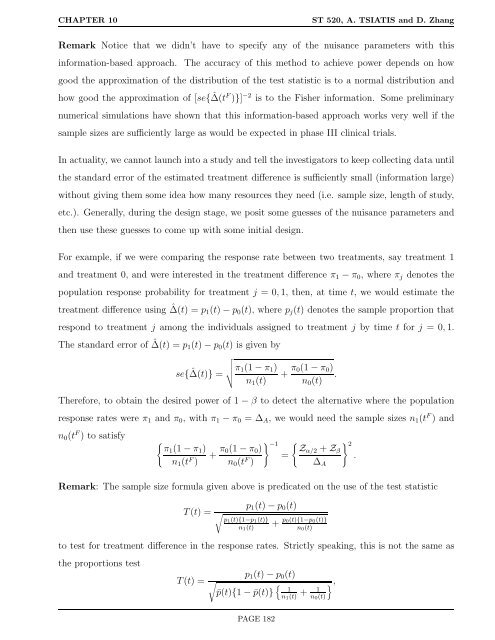ST 520 Statistical Principles of Clinical Trials - NCSU Statistics ...
ST 520 Statistical Principles of Clinical Trials - NCSU Statistics ...
ST 520 Statistical Principles of Clinical Trials - NCSU Statistics ...
Create successful ePaper yourself
Turn your PDF publications into a flip-book with our unique Google optimized e-Paper software.
CHAPTER 10 <strong>ST</strong> <strong>520</strong>, A. TSIATIS and D. Zhang<br />
Remark Notice that we didn’t have to specify any <strong>of</strong> the nuisance parameters with this<br />
information-based approach. The accuracy <strong>of</strong> this method to achieve power depends on how<br />
good the approximation <strong>of</strong> the distribution <strong>of</strong> the test statistic is to a normal distribution and<br />
how good the approximation <strong>of</strong> [se{ ˆ ∆(t F )}] −2 is to the Fisher information. Some preliminary<br />
numerical simulations have shown that this information-based approach works very well if the<br />
sample sizes are sufficiently large as would be expected in phase III clinical trials.<br />
In actuality, we cannot launch into a study and tell the investigators to keep collecting data until<br />
the standard error <strong>of</strong> the estimated treatment difference is sufficiently small (information large)<br />
without giving them some idea how many resources they need (i.e. sample size, length <strong>of</strong> study,<br />
etc.). Generally, during the design stage, we posit some guesses <strong>of</strong> the nuisance parameters and<br />
then use these guesses to come up with some initial design.<br />
For example, if we were comparing the response rate between two treatments, say treatment 1<br />
and treatment 0, and were interested in the treatment difference π1 − π0, where πj denotes the<br />
population response probability for treatment j = 0, 1, then, at time t, we would estimate the<br />
treatment difference using ˆ ∆(t) = p1(t) − p0(t), where pj(t) denotes the sample proportion that<br />
respond to treatment j among the individuals assigned to treatment j by time t for j = 0, 1.<br />
The standard error <strong>of</strong> ˆ ∆(t) = p1(t) − p0(t) is given by<br />
se{ ˆ �<br />
�<br />
�<br />
∆(t)} = �π1(1 − π1)<br />
n1(t) + π0(1 − π0)<br />
.<br />
n0(t)<br />
Therefore, to obtain the desired power <strong>of</strong> 1 − β to detect the alternative where the population<br />
response rates were π1 and π0, with π1 − π0 = ∆A, we would need the sample sizes n1(t F ) and<br />
n0(t F ) to satisfy<br />
�<br />
π1(1 − π1)<br />
n1(tF ) + π0(1 − π0)<br />
n0(tF �−1 =<br />
)<br />
� Zα/2 + Zβ<br />
Remark: The sample size formula given above is predicated on the use <strong>of</strong> the test statistic<br />
T(t) =<br />
p1(t) − p0(t)<br />
� p1(t){1−p1(t)}<br />
n1(t)<br />
∆A<br />
+ p0(t){1−p0(t)}<br />
n0(t)<br />
to test for treatment difference in the response rates. Strictly speaking, this is not the same as<br />
the proportions test<br />
T(t) =<br />
p1(t) − p0(t)<br />
�<br />
¯p(t){1 − ¯p(t)} � 1 1 + n1(t) n0(t)<br />
PAGE 182<br />
�,<br />
� 2<br />
.
















